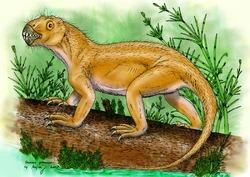| Suminia Fossil range: Late Permian | |
|---|---|
 Suminia getmanovi | |
| Scientific classification
| |
|
Venyukoviamorpha | |
|
Venyukoviidae | |
|
Suminia | |
| |
Suminia is a genus of stem-mammal, in the clade Anomodontia, which lived 260 million years ago in the Late Permian ("zone II"). This anomodont was discovered in Kotelnich on the Vyatka River Russia. It is found in sandstone sediment, so most likely represents a delta-dwelling species, but this is not conclusive, as other habitats may have been involved but the species was never fossilized in that habitat. S. getmanovi has teeth that are heavily abraded, suggesting plant material of high silica content. Newer fossils indicate that it led an arboreal lifestyle. Suminia was relatively small, reaching about 20 inches in length. Suminia was originally described in 1994 based on only a skull, and a new Proceedings of the Royal Society B paper has stirred a great deal of media coverage due to the discovery of new, better-preserved specimens studied by paleontologists Jorg Frobisch and Robert Reisz. Frobisch and Reisz determined that Suminia was probably an arboreal animal, and it is (so far) the earliest arboreal vertebrate known. The new Suminia material consists of a single block containing the articulated remains of over a dozen individual animals. The individuals on the slab appear to range from sub-adults to adults, and the preservation of the bones suggests rapid burial caused by some sort of minor catastrophe.[1][2]
The Permian deposits in which Suminia was found is relatively well-sampled. During the Late Permian, Suminia's local environment supported a large number of herbivores (about 83% of all the vertebrates present) and a much smaller number of carnivores (about 13% of all the vertebrates present). The authors hypothesize that it was competition with other herbivores that might have driven some synapsids into the trees. These plants would have been a resource unexploited by other vertebrates, and this may have allowed for the evolution of Suminia from more terrestrially-adapted ancestors.[2]
Features[]

One of the best-preserved and most complete skeletons of the tree-climbing synapsid Suminia getmanovi.

The hand of Suminia (right) compared to terrestrial anomodonts Galechirus (middle) and Robertia (left). Note the claw-like finger bones and divergent "thumb" of Suminia.
The teeth were quiet large for its size containing a single cusp per tooth with many serrations as in a serrated knife. These teeth were replaced throughout its life cycle. The eyesocket was fairly large and placed near the temporal opening, separated by a thin postorbital bar. Frobisch and Reisz studied the specimens in detail, and determined that Suminia had very long fingers, large, grasping hands when compared to the rest of its arm, claw-like bones at the ends of its fingers, and a first digit set off at an angle to function like an opposable, grasping thumb.[3] The hands of Suminia widely differed from those of terrestrial anomodonts and more closely resembled those of other arboreal vertebrates from various groups and time periods. It appeared that lineages that adopted an arboreal lifestyle evolved similar traits over and over again, these similarities being due to convergent evolution. Comparisons between Suminia and living arboreal vertebrates supported this hypothesis, and Frobisch and Reisz make a very well-supported case that Suminia moved through the trees by clinging and grasping.[2]
Classification[]
See also[]
External links[]
References[]
- ^ Jörg Fröbisch and Robert R. Reisz (2009). The Late Permian herbivore Suminia and the early evolution of arboreality in terrestrial vertebrate ecosystems. Proc R Soc B. doi:10.1098/rspb.2009.0911
- ^ a b c Suminia: Life in the Trees 260 Million Years Ago by Brian Switek of ScienceBlogs.
- ^ Field Museum scientist describes first vertebrate to live in trees
- Patricia Vickers-Rich and Thomas H. Rich, The Great Russian Dinosaurs, Gunter Graphics, 1993, Pg 37.
- Rybczynski, N. (2000), Cranial anatomy and phylogenetic position of Suminia getmanovi, a basal anomodont (Amniota: Therapsida) from the Late Permian of Eastern Europe", Zoological Journal of the Linnean Society 130:329-373